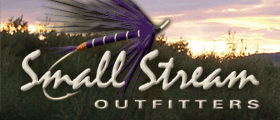 |
 |
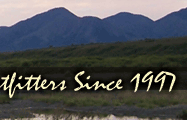 |
| AN INTRODUCTION TO THE FISH YOU'RE AFTER WITH SMALL STREAM OUTFITTERS | |||
| Summer Steelhead | Winter Steelhead | ||
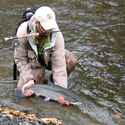 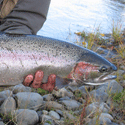 |
Although Summer Steelhead begin to enter streams in May and continue through August they don't spawn until the Fall which make them a very different fish than their seasonal brethren, the Winter steelhead. Since they spend so long in the river, Summer steelhead exhibit more trout-type behavior like holding in shallow water and striking at natural insects (including dry flies). These fish are very wary, due mostly to low water and intense sunlight. The best time to target these fish is before the sun hits the water and in the evening once it begins to set. Cloudy days are also excellent and a little rain or mist is even better. On the coast these fish tend to stack up in certain areas (big pools and prime runs) throughout the Summer before making their way to spawning grounds with the first good rain of the Fall. September and October is the best month to chase these fish upriver with a fly, although numerous fish are taken in the heat of the Summer. Summer steelhead are generally smaller than Winter fish and average 6-8 pounds with big fish in the 12 pound class. 6 and 7 wts with floating lines and long leaders are the ticket for these fish. The swing technique is most often used and fish are taken on skated dry flies every year! RIVERS TO CHOOSE FROM: Siletz, Nestucca, Clackamas, Sandy, McKenzie, Hidden Stream Beta |
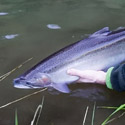 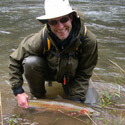 |
Winter steelhead are available to fly anglers for over five months. Their size, power, numbers and willingness to take a fly make them our most guided fish. We begin chasing hatchery fish in around Thanksgiving and gradually transition over to native runs by early Februrary. We'll then continue chase native and broodstock fish through late-April. Winter steelhead are a hearty species surviving well in numerous rivers on the Coast and in the Willamette Valley. Water conditions throughout the Winter months vary greatly and can affect fishing. We're always keeping a careful eye on the river levels, so feel free to contact us for the most current conditions. Oregon winter steelhead range from 6-25 lbs. with average fish around 10 lbs. Fish over 15 lbs. are often hooked on fly rods, however landing them is a true challenge. Winter steelheading with a fly rod is a unique experience and one that every fly angler should participate in. For some, the wet, cold, blustery weather and hours between strikes isn't their cup of tea, but for others the anticipation, excitement and chance to land one of Oregon's most powerful and beautiful gamefish keeps them coming back again and again. On average, anglers hook-up 1-5 times daily and land just under 50% of fish hooked. 8 weight fly rods and floating lines are the most commonly used equipment. Currents and river levels dictate the amount of additional weight on the line needed to present to these amazing fish. Both swing and nymphing techniques are used, although nymphing has proved time and again to be more effective. RIVERS TO CHOOSE FROM: Siletz, Nestucca, North Fork Nehalem, Hidden Stream Alpha, Hidden Stream Beta, Sandy, Clackamas |
| Chinook Salmon | Coho Salmon | ||
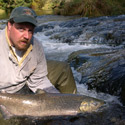 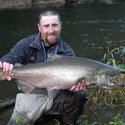 |
FALL CHINOOK (KINGS) SPRING CHINOOK (SPRINGERS) RIVERS TO CHOOSE FROM: Fall Run; Siletz, North Fork Nehalem, Nestucca, Hidden Stream Alpha, Hidden Stream Beta. Spring Run; Sandy or Clackamas |
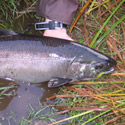 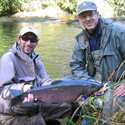 |
In the last few years (especially 2009) the Coho salmon runs both on the coast and in the valley have made a tremendous comeback. Selected native coho openings are now beginning to appear on rivers like the Siletz and Yaquina. Rivers with hatchery runs like like the N. Fork Nehalem and Sandy traditionally fish very well from mid-September through mid-October. Other coastal streams with good runs of native fish like the Nestucca and Siletz peak slightly later in the year. Catch and release fishing for native coho can be good into late-November. When angler timing is spot-on it is not uncommon to catch coho, chinook and sea-run cutthroat on the same fly in the same day. Favorite patterns for these fish include clousers, bunny leeches and egg patterns.
RIVERS TO CHOOSE FROM: Sandy, Nestucca, Hidden Stream Alpha, Hidden Stream Beta, N. Fork Nehalem |
| Cutthroat Trout | Rainbow Trout | ||
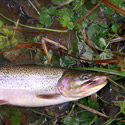 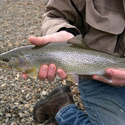 |
SEA-RUN CUTTHROAT NATIVE CUTTHROAT RIVERS TO CHOOSE FROM: Siletz, Nestucca, Hidden Stream Alpha, Hidden Stream Beta, N. Fork Nehalem |
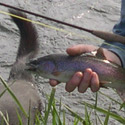 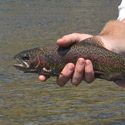 |
Aside from stocked trout in lakes and juvenille steelhead, the Oregon Coast does not have a population of native river rainbow trout. To chase this famous fish you'll have to make your way to the Willamette Valley to chase them in one of several West Cascade streams. Our favorite is the McKenzie which fishes from March-October for both hatchery and wild rainbow trout. 4 and 5wts are generally used along with floating lines and traditional trout patterns. Most standard western stream trout patterns have a place here, but there are several specific seasonal catches. Check with your guide for the prevailing hatch during your stay. RIVERS TO CHOOSE FROM: McKenzie River, Clackamas River |